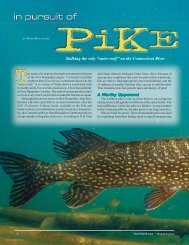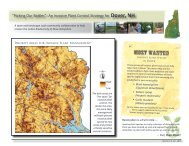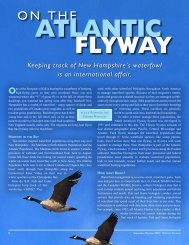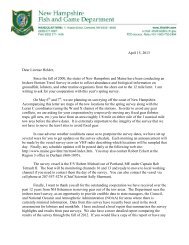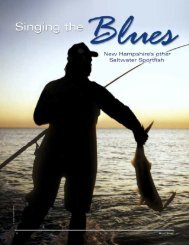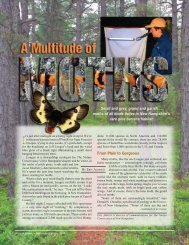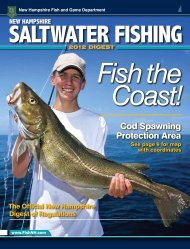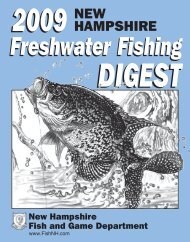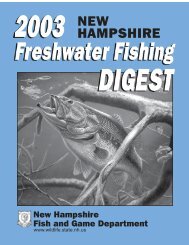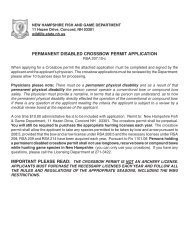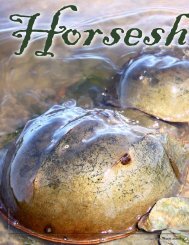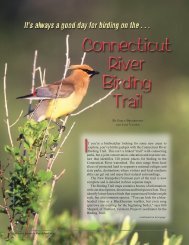Insect Repellents - Which one should you use?
Insect Repellents - Which one should you use?
Insect Repellents - Which one should you use?
You also want an ePaper? Increase the reach of your titles
YUMPU automatically turns print PDFs into web optimized ePapers that Google loves.
Family, Home & Garden Education Centerpractical solutions to everyday questionsToll free Info Line 1-877-398-4769M-F • 9 AM - 2 PMW • 5 - 7:30 PM<strong>Insect</strong> <strong>Repellents</strong>The term “insect repellent” doesn’t accurately reflect how these materials work. They don’t actually repelinsects, but rather block the receptors that mosquitoes, gnats, punkies, no-see-ums and other insects<strong>use</strong> to detect appropriate hosts for them to bite.Blocking those receptors stops the insects from biting, so a more accurate term might be “bite-preventingsubstances.” By the way, they can also repel some insect relatives such as ticks.The effectiveness of repellents varies with the active ingredient(s), the concentration, and the target species.Products come as lotions, pump sprays, pressurized cans, and wipes. <strong>Which</strong> <strong>one</strong> is best? That’s for<strong>you</strong> to decide. Look at the list of active ingredients and their concentrations to help decide which <strong>one</strong> tobuy. Always follow label directions when using repellents.DEET is an acronym for the long technical name: N, N-diethyl-meta-toluamide. Developed in 1946,DEET has been <strong>use</strong>d extensively since then and serves as the standard mosquito repellent against whichnew candidate materials are tested.In addition to working on mosquitoes, it works well on fleas, biting midges (punkies, no-see-ums) andblack flies. It doesn’t work well on snipe flies, deer flies, greenheads or horse flies. (By the way, no repellentsreally work on those groups.) Ticks and chiggers are closely related to insects, and DEET workson them, too.<strong>Repellents</strong> that have higher concentrations of DEET generally last longer and are more effective (toa point) than those with low concentrations. DEET <strong>should</strong> never be allowed into mucous membranes(nose, mouth, eyes), and <strong>should</strong> never be <strong>use</strong>d on infants less than two months old. Officials don’t recommendusing products containing more than 30 percent DEET. A few people are allergic to it. DEET isgreasy and also dissolves some plastics and finishes.Picaridin is a relatively new repellent. It first became available in U.S. products in 2005. For mostspecies, it’s as effective as DEET, but appears to lack some of DEET’s shortcomings. It doesn’t dissolveplastics or finishes, and no allergic reactions have been noted. Perhaps as products containing picaridinbecome more widely <strong>use</strong>d, some shortcomings might appear. Picaridin works well on mosquitoes,and also biting midges (punkies/no-see-ums) and chiggers. It works almost as well as DEET on ticks.N.H.-registered repellents with low picaridin concentration are labeled for mosquitoes, biting flies andchiggers. Those with higher concentrations include ticks on the label. Avon, Cutter, Go Ready, Natrapel,OFF, Repel, Sawyer and Walgreens are brand names that include picaridin repellents registered in NewHampshire.
Oil of Lemon Eucalyptus is <strong>one</strong> of many “natural” products. Research has shown that repellentsbased on natural oils or herbs are less effective on mosquitoes than products based on picaridin orDEET. According to the Centers for Disease Control and Prevention, oil of lemon eucalyptus (activeingredient: p-menthane 3,8-diol [PMD]), tested against U.S. mosquitoes “provided protection similar torepellents with low concentrations of DEET.” The data showed that this was effective only for the firstfew minutes of the testing. After that, it was much less effective.Oil of lemon eucalyptus <strong>should</strong> not be <strong>use</strong>d on children <strong>you</strong>nger than three years old. S.C. Johnson(OFF) produces two products containing PMD that are registered in New Hampshire. One (towelettes)has 8 percent PMD, and lists black flies, gnats, mosquitoes, no see-ums on the label. The other (liquid)has 10 percent PMD, and lists those pests plus “ticks, chiggers and bugs.”Citr<strong>one</strong>lla is a natural product with limited repellence to mosquitoes. It is incorporated in some candlesand torches, in addition to repellents. The material is derived from two grasses native to tropical Asia:Cymbopogon nardus (L.)Rendle (“mana grass”) and C. winterianus Jowitt.2-Undecan<strong>one</strong> is a chemical derived from wild tomato plants. Some chemical registries refer to thesame compound as methyl nonyl ket<strong>one</strong>. In preliminary tests on American dog ticks and some mosquitoes,it worked as well as or better than DEET. EPA registered the material as an insect repellent in 2007.As this is written (February 2009), it isn’t yet available in New Hampshire. BioUD is a trade name forproducts with this active ingredient. A search of the N.H. pesticide registry uncovered a surprise: wehave many products with this chemical, registered to repel or train dogs & cats, but not formulated for<strong>use</strong> as insect repellents.IR3535 (ethyl butyl acetyl aminoproprionate) has several chemical names. The chemical was designedin the early 1970s and has been available in Europe since the mid-1970s. Tests show that it works moderatelywell on mosquitoes and fairly well on blacklegged tick. At least three manufacturers (Sawyer,Chattem, and Avon) make products that combine sunblock and insect repellent, contain this chemical,and are registered for <strong>use</strong> in NH. The Chattem (“Bullfrog Mosquito Coast”) and Sawyer products typicallyhave 20 percent IR3535 and are registered for mosquitoes. The Avon products have lower percentageof active ingredients and are registered for “biting midges, black flies, deer ticks, gnats, mosquitoes,no-see-ums, and sandflies.”Other repellentsResearch continues to turn up new candidates for registration as repellents. Recent examples includeA13-37220 and tansy essential oil. Perhaps these will eventually appear in commercial mosquito or tickrepellents.Amitraz and permethrin are two artificial chemical pesticides for ticks that show what is sometimescalled repellency. Rather than being true repellents, they seem to create irritation and toxicity symptomsin ticks, which ca<strong>use</strong> ticks to drop off and prevent them from attaching. Tick control products containingfipronil can also prevent tick attachment, which some people interpret as “repellency.”Dimethyl phthalate, R-11 and ethyl hexane diol were fairly effective against mosquitoes and black flies,but they are no longer available in repellents. They were discontinued in the early 1990s, based on healthconcerns.
Labels and the registration process<strong>Repellents</strong> are classified as pesticides by the U.S. Environmental Protection Agency. As such, in order tobe sold in this country, they must first be registered with the EPA. Companies submit product information(contents, testing results, targets, proposed label, etc) and EPA looks to see if the products are “safe”for <strong>use</strong> as directed. For most chemicals, they also look to see if they work.For <strong>one</strong> group of chemicals, effectiveness testing is much reduced or not required by EPA. This is for“natural” products composed of chemicals on the federal “generally regarded as safe” (GRAS) list. TheGRAS list includes materials in food, such as black pepper, many essential oils, caffeine, ethyl alcohol,spices, etc. <strong>Insect</strong> repellants that contain only GRAS-list ingredients don’t have the same rigorous testingrequirement to prove their effectiveness, which is why a “natural” repellent might not work as wellas <strong>one</strong> tested against the standard (DEET).When a product is accepted by EPA, the label becomes a legal document that we are all required to followfor <strong>use</strong>. We aren’t allowed to <strong>use</strong> (or recommend) products in a manner that is “inconsistent withtheir labeling.” Please read and follow label directions. They are there to ensure <strong>you</strong>r safety and maximizeeffectiveness of the product.This publication or parts thereof may be reproduced and distributed, provided that credit is given to theauthor and UNH Cooperative Extension as the source. Where trade names are menti<strong>one</strong>d, no discriminationis intended and no endorsement is implied. Pesticide registrations change frequently. For the latestinformation on registration of a pesticide in New Hampshire, contact the Pesticide Control Divisionof the NH Dept. of Agriculture at 603-271-3550 or visit their website at http://agriculture.nh.gov/divisions/pesticide_control/pesticide_registration.htmFact sheet by Dr. Alan T. Eaton, UNH Cooperative Extension Entomology SpecialistVisit our website: extension.unh.eduUNH Cooperative Extension programs and policies are consistent with pertinent Federal and State laws and regulationson non-discrimination regarding age, color, handicap, national origin, race, religion, sex, sexual orientation, or veterans status.2/2009



